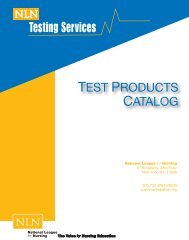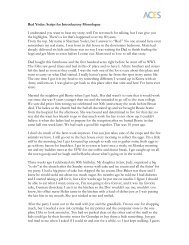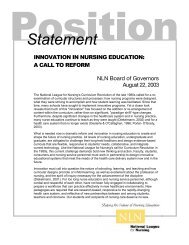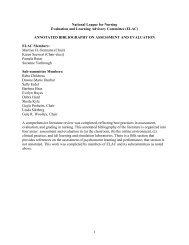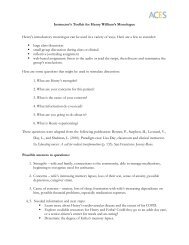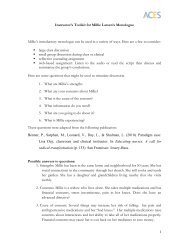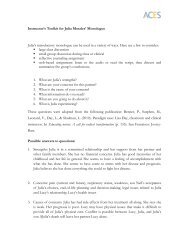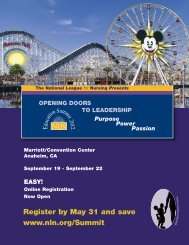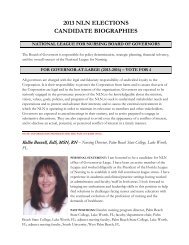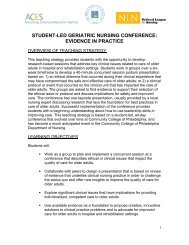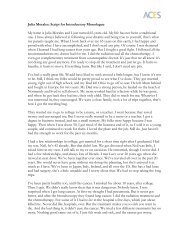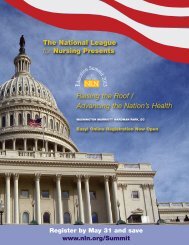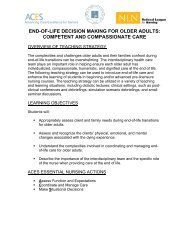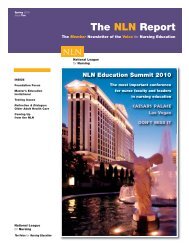Instructor's Toolkit for Red Yoder's Second Monologue Red's second ...
Instructor's Toolkit for Red Yoder's Second Monologue Red's second ...
Instructor's Toolkit for Red Yoder's Second Monologue Red's second ...
Create successful ePaper yourself
Turn your PDF publications into a flip-book with our unique Google optimized e-Paper software.
Instructor’s <strong>Toolkit</strong> <strong>for</strong> <strong>Red</strong> Yoder’s <strong>Second</strong> <strong>Monologue</strong><br />
<strong>Red</strong>’s <strong>second</strong> monologue can also be used in a variety of ways. Here are a few to consider:<br />
• large class discussion<br />
• small group discussion during class or clinical<br />
• reflective journaling assignment<br />
• web-based assignment: listen to the audio or read the script, then discuss and<br />
summarize the group’s conclusions.<br />
1. What are <strong>Red</strong>’s strengths<br />
2. What are your concerns <strong>for</strong> this patient<br />
3. What is the cause of your concern<br />
4. What in<strong>for</strong>mation do you need<br />
5. What are you going to do about it<br />
6. What is “<strong>Red</strong>” experiencing<br />
These questions were adapted from the following publication: Benner, P., Sutphen,<br />
M., Leonard, V., Day, L., & Shulman, L. (2010). Paradigm case: Lisa Day, classroom<br />
and clinical instructor. In Educating nurses: A call <strong>for</strong> radical trans<strong>for</strong>mation (p. 133).<br />
San Francisco: Jossey-Bass.<br />
Possible answers to questions:<br />
1. What are <strong>Red</strong>’s strengths<br />
• <strong>Red</strong> has assessed his wound and his blood glucose and is aware that there is a<br />
problem.<br />
2. What are your concerns <strong>for</strong> this patient<br />
• <strong>Red</strong>’s foot is red and swollen and he has a loss of appetite.<br />
3. What is the cause of your concern<br />
• Older adults may have an atypical presentation of sepsis.<br />
• <strong>Red</strong> does not indicate that he is going to call his son or doctor to talk about<br />
how he is feeling and what his foot looks like.<br />
4 & 5. Needed in<strong>for</strong>mation and next steps –<br />
• Need to assess <strong>for</strong> signs and symptoms of infection.<br />
• Need to be aware of how an infection may present in older adults. This could<br />
include falls, decreased appetite, or fluid intake, confusion, or change in<br />
functional status.<br />
6. What is <strong>Red</strong> experiencing<br />
• From his assessment, there is a local and perhaps systemic infection<br />
occurring.
The ACES Essential Nursing Actions can serve as a guide to learners when deciding what<br />
interventions may be appropriate <strong>for</strong> the older adult in this situation.<br />
ACES Framework<br />
Essential Nursing Actions<br />
Assess<br />
Function<br />
and<br />
Expectations<br />
Coordinate<br />
and<br />
Manage<br />
Care<br />
Use<br />
Evolving<br />
Knowledge<br />
Make<br />
Situational<br />
Decisions<br />
• Assess the older adult’s individual aging pattern and functional status using<br />
standardized assessment tools.<br />
• Use effective communication techniques to recognize, respond to, and respect<br />
an older adult’s strengths, wishes, and expectations.<br />
• Include findings of assessment of older adult’s cognition, mood, physical<br />
function, and com<strong>for</strong>t to fully assess the individual aging pattern.<br />
• Manage chronic conditions, including atypical presentations, in daily life and<br />
during life transitions to maximize function and maintain independence.<br />
• Assist older adults and families/caregivers to access knowledge and evaluate<br />
resources.<br />
• Advocate during acute exacerbations of chronic conditions to prevent<br />
complications.<br />
• Understand geriatric syndromes and unique presentations of common diseases in<br />
older adults.<br />
• Access and use emerging in<strong>for</strong>mation and research evidence about the special<br />
care needs of older adults and appropriate treatment options.<br />
• Interpret findings and evaluate clinical situations in order to provide high quality<br />
nursing care based on current knowledge and best practices.<br />
• Analyze risks and benefits of care decisions in collaboration with the<br />
interdisciplinary team and the older adult and family/caregivers.<br />
• Evaluate situations where standard treatment recommendations need to be<br />
modified to manage care in the context of the older adult’s needs and life<br />
transitions.<br />
• Consider the older adult’s wishes, expectations, resources, cultural traditions, and<br />
strengths when modifying care approaches.



